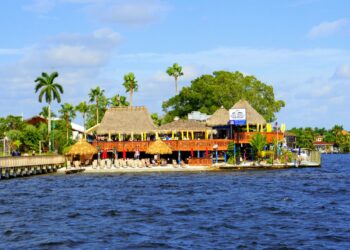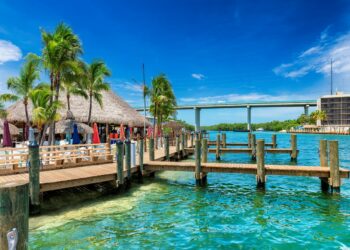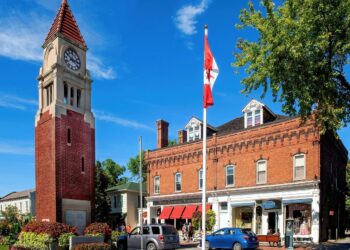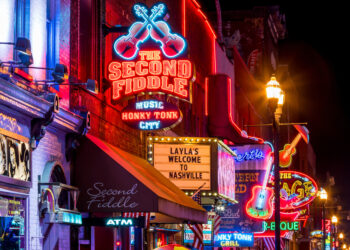Copenhagen is the centre of vibrant Danish life and one of the oldest capitals in Europe. It is considered the country’s business centre, offering a high quality of life and an eco-friendly environment. Let’s take a look at some of the most significant places to visit in Copenhagen.
Major Attractions
Places to visit in Copenhagen: The Black Diamond
If you are a real bookworm, the Royal Library is a must-see destination in Denmark. The library’s book collection is placed in four sections, the most remarkable of which is the Black Diamond, a new section of the Royal Library, the idea of which belongs to Queen Margrethe. It was unveiled in 1999 and is covered with Absolute Black granite from Zimbabwe. The section is located right at the Copenhagen harbour and creates a spectacular scene. The contrast between blue water and the black square building is stunning.
Affiliate Disclaimer: Our blog posts may contain affiliate links. If you make a purchase through these links, we receive a modest commission at no extra cost to you. These commissions help us fund our team of travel writers, allowing us to continue providing you with the latest travel news, tips, and inspiration. Your support keeps this blog alive and thriving, and we appreciate it immensely. Thank you!

Places to visit in Copenhagen: Amalienborg Palace
The answer should come without hesitation if anyone ever asks you what Denmark is full of. Castles and palaces. It’s understandable, as Danes take care of their royalties very well. And really, in a century where there is a deadly shortage of princes, the Danish royal family must be kept as a rare pearl. After all, the country’s royal heritage is one of the significant themes of tourist tours.
Today the most important Danish palace is the Amalienborg Palace, as it’s the official residence of Her Majesty Queen Margrethe, Prince Henrik and their son and crown prince Frederik. Amalienborg Palace is a luxurious palace consisting of not one but four buildings dating back to the 18th century. Four noble countries built those four buildings, as King Frederik was a little too economical and didn’t want to spend his money on a new castle. In return for this extraordinary gift, those families were freed from taxes. A fair bargain.

Visit the castle at noon. The Changing of Guards will be a unique experience for tourists from countries with no monarchs.
Places to visit in Copenhagen: Churches
- For Frelsers Kirke: The church is closely connected to King Christian V., a Danish monarch that enjoyed absolute powers. A golden staircase curls around the church tower and culminates in a golden globe with a statue on the top. The tower is not only an exterior design but also a platform to view the Danish capital in all its beauty. The view includes the whole city and the Danish – Swedish Øresund bridge, which links the two countries. The experience is guaranteed to be unforgettable after you reach the top, having climbed 400 stairs. Talking about the church’s interior design, it’s worth mentioning that some ideas, particularly those used on the ceiling, belonged to king Christian V himself. In a word, Vor Frelsers Kirke is the reflection of monarchs’ tastes and tendencies.
- Copenhagen Cathedral: The Copenhagen Cathedral, also known as Our Lady’s Church, is one of the biggest cathedrals in Denmark. Its construction took around 20 years, starting in 1810 and ending in 1829. Something obviously was wrong either with the place or the way of construction, as fire destroyed the church every time it was rebuilt, each time with new beauty. The first construction occurred in the 13th century, when today’s magnificent cathedral was a small, modest, simple church. The church can house more than a thousand visitors, making this an excellent venue for major events. One such event was the wedding of Frederik and Mary Donaldson. It took place in 2004 and naturally gained a nationwide audience, as princes have become rare lately.

- The Marble Church: The Marble Church was ordered by King Frederik V. The Marble Church was considered an unseen luxury then. This was the reason that the building of this church was highly prolonged. The absence of satisfactory financial needs caused the construction to be shut down several times. Sometimes it was stopped temporarily, in other times, the structure was thought to be ended once and for all. Only in 1874 did Mr C.F. Tietgen finance the construction, and the church, the marble imported from Norway, was finally ready for visitors.
Places to visit in Copenhagen: The New Carlsberg Glyptotek
The New Carlsberg Glyptotek is one of the best among Copenhagen museums. Art-lovers will particularly like this institution that houses art from some of the wealthiest periods in history.
A brewer named Carl Jacobsen from Carlsberg is a critical figure in the museum’s history. Besides the enormous amount of money provided by the state, Jacobsen donated his collection, which was so big it could be compared to some of the most famous museums in Denmark in the 19th century. Jacobsen was a devoted collector, starting his “career” during a trip to Italy. His first item was a portrait of a man dating back to 540 BC. Later in his life, he collected objects belonging to ancient Egypt and Rome from the periods of 3000 BC and 500 AD. The exhibitions are not limited only to ancient art; they also include works from the 18th and the 19th centuries art originated in Denmark and France. After assembling a respectable collection, he donated it to the museum in 1888.

Sundays are usually free-admission days for the museums so plan your visit then. Besides ancient and modern art, the museum also has a book store that will keep even the pickiest reader happy.
Places to visit in Copenhagen: The Little Mermaid
The symbol of Copenhagen is, of course, the Little Mermaid. The statue of a stone mermaid quietly resting on a rock is as remarkable as the story it is drawn from. The author is the most famous Danish storyteller Hans Christian Andersen. The statue was, however, commissioned by Carl Jacobsen in 1909. The architect of this statue, Edvard Eriksen, created the mermaid, her body resembling his wife’s, while ballerina Ellen Price modelled for the head.
The story
Once, many many years ago, the Øresund waters were full of the most attractive mythical creatures, mermaids. Øresund was even considered to be their home. So after turning 15, the little mermaid, the youngest of the sea king’s daughters, is allowed to visit the surface. During her trip she encounters a prince, whom she saves from drowning and leaves on the beach. A temple girl finds the prince, and the mermaid, sure for the prince’s safety, leaves the surface. But she has fallen in love with the prince; moreover, she wants to be a human and have an eternal soul as they do. She decides to make a deal with the witch, who promises her an immortal soul and a pair of human legs if she agrees to pay by her voice.

There is also a trick; the little mermaid will become sea foam if the prince marries another woman. So she agrees and leaves the sea only to find out the prince is in love with the temple girl, who happens to be a princess.
When the prince and the princess marry, the little mermaid is given a second chance: to kill the prince and return to her mermaid life or turn into foam. But, of course, the mermaid can’t make herself kill her beloved one and throws herself into the sea. Still, instead of dying, she becomes a daughter of the air, promised to obtain eternal life by saving children.
The fairy tale is one of the best pieces of storytelling. It has been adapted in several films and animation movies. The little mermaid is usually among the top places to visit in Copenhagen for tourists.











